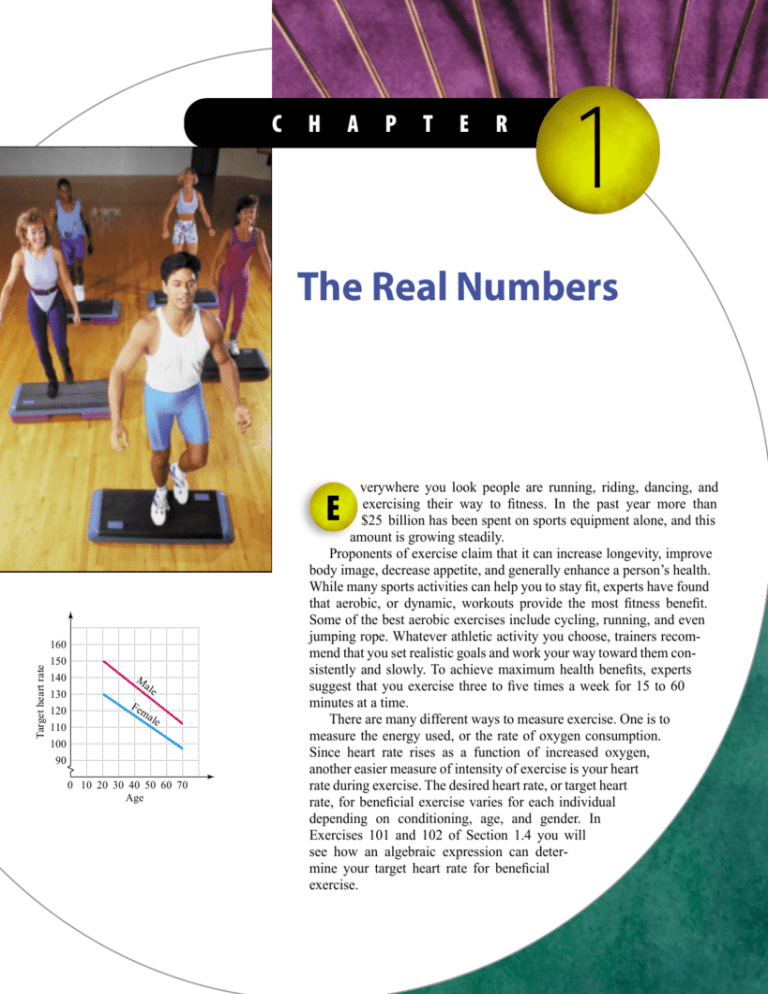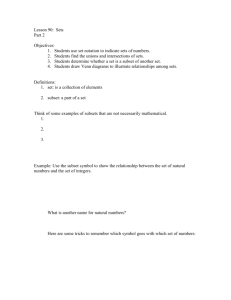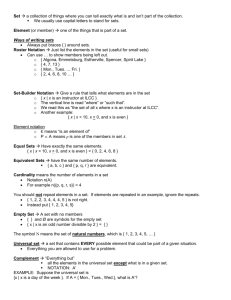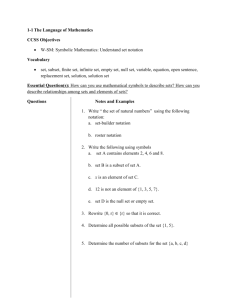The Real Numbers
advertisement

C H A P T E R 1 The Real Numbers verywhere you look people are running, riding, dancing, and exercising their way to fitness. In the past year more than $25 billion has been spent on sports equipment alone, and this amount is growing steadily. Proponents of exercise claim that it can increase longevity, improve body image, decrease appetite, and generally enhance a person’s health. While many sports activities can help you to stay fit, experts have found that aerobic, or dynamic, workouts provide the most fitness benefit. Some of the best aerobic exercises include cycling, running, and even jumping rope. Whatever athletic activity you choose, trainers recommend that you set realistic goals and work your way toward them consistently and slowly. To achieve maximum health benefits, experts suggest that you exercise three to five times a week for 15 to 60 minutes at a time. There are many different ways to measure exercise. One is to measure the energy used, or the rate of oxygen consumption. Since heart rate rises as a function of increased oxygen, another easier measure of intensity of exercise is your heart rate during exercise. The desired heart rate, or target heart rate, for beneficial exercise varies for each individual depending on conditioning, age, and gender. In Exercises 101 and 102 of Section 1.4 you will see how an algebraic expression can determine your target heart rate for beneficial exercise. Target heart rate E 160 150 140 130 120 110 100 M Fe ale ma le 90 0 10 20 30 40 50 60 70 Age 2 (1-2) Chapter 1 The Real Numbers 1.1 SETS Every subject has its own terminology, and algebra is no different. In this section we will learn the basic terms and facts about sets. In this section ● Set Notation ● Union of Sets ● Intersection of Sets ● Subsets ● Combining Three or More Sets Set Notation A set is a collection of objects. At home you may have a set of dishes and a set of steak knives. In algebra we generally discuss sets of numbers. For example, we refer to the numbers 1, 2, 3, 4, 5, and so on as the set of counting numbers or natural numbers. Of course, these are the numbers that we use for counting. The objects or numbers in a set are called the elements or members of the set. To describe sets with a convenient notation, we use braces, , and name the sets with capital letters. For example, A 1, 2, 3 means that set A is the set whose members are the natural numbers 1, 2, and 3. The letter N is used to represent the entire set of natural numbers. A set that has a fixed number of elements such as 1, 2, 3 is a finite set, whereas a set without a fixed number of elements such as the natural numbers is an infinite set. When listing the elements of a set, we use a series of three dots to indicate a continuing pattern. For example, the set of natural numbers is written as N 1, 2, 3, . . .. The set of natural numbers between 4 and 40 can be written study tip Find a group of students to work with outside of class. Don’t just settle for answers. Make sure that everyone in the group understands the solution to a problem. You really will understand a concept when you can explain it to someone else. 5, 6, 7, 8, . . . , 39. Note that since the members of this set are between 4 and 40, it does not include 4 or 40. Set-builder notation is another method of describing sets. In this notation we use a variable to represent the numbers in the set. A variable is a letter that is used to stand for some numbers. The set is then built from the variable and a description of the numbers that the variable represents. For example, the set B 1, 2, 3, . . . , 49 is written in set-builder notation as B x x is a natural number less than 50. ↑ ↑ The set of numbers such that ↑ condition for membership This notation is read as “B is the set of numbers x such that x is a natural number less than 50.” Notice that the number 50 is not a member of set B. The symbol is used to indicate that a specific number is a member of a set, and indicates that a specific number is not a member of a set. For example, the statement 1 B is read as “1 is a member of B,” “1 belongs to B,” “1 is in B,” or “1 is an element of B.” The statement 0 B is read as “0 is not a member of B,” “0 does not belong to B,” “0 is not in B,” or “0 is not an element of B.” Two sets are equal if they contain exactly the same members. Otherwise, they are said to be not equal. To indicate equal sets, we use the symbol . For sets that are not equal we use the symbol . The elements in two equal sets do not need to be written in the same order. For example, 3, 4, 7 3, 4, 7 and 2, 4, 1 1, 2, 4, but 3, 5, 6 3, 5, 7. 1.1 E X A M P L E 1 Sets (1-3) 3 Set notation Let A 1, 2, 3, 5 and B x x is an even natural number less than 10. Determine whether each statement is true or false. a) 3 A b) 5 B c) 4 A d) A N e) A x x is a natural number less than 6 f) B 2, 4, 6, 8 Solution a) True, because 3 is a member of set A. b) False, because 5 is not an even natural number. c) True, because 4 is not a member of set A. d) False, because A does not contain all of the natural numbers. e) False, because 4 is a natural number less than 6, and 4 A. f) True, because the even counting numbers less than 10 are 2, 4, 6, and 8. ■ Union of Sets Any two sets A and B can be combined to form a new set called their union that consists of all elements of A together with all elements of B. Union of Sets If A and B are sets, the union of A and B, denoted A B, is the set of all elements that are either in A, in B, or in both. In symbols, A A B x x A or x B. B In mathematics the word “or” is always used in an inclusive manner (allowing the possibility of both alternatives). The diagram in Fig. 1.1 can be used to illustrate A B. Any point that lies within circle A, circle B, or both is in A B. Diagrams (like Fig. 1.1) that are used to illustrate sets are called Venn diagrams. AB FIGURE 1.1 E X A M P L E helpful 2 hint To remember what “union” means think of a labor union, which is a group formed by joining together many individuals. Union of sets Let A 0, 2, 3, B 2, 3, 7, and C 7, 8. List the elements in each of the following sets. a) A B b) A C Solution a) A B is the set of numbers that are in A, in B, or in both A and B. A B 0, 2, 3, 7 b) A C 0, 2, 3, 7, 8 A ■ B Intersection of Sets AB FIGURE 1.2 Another way to form a new set from two known sets is by considering only those elements that the two sets have in common. The diagram shown in Fig. 1.2 illustrates the intersection of two sets A and B. 4 (1-4) Chapter 1 helpful hint To remember the meaning of “intersection,” think of the intersection of two roads. At the intersection you are on both roads. The Real Numbers Intersection of Sets If A and B are sets, the intersection of A and B, denoted A B, is the set of all elements that are in both A and B. In symbols, A B x x A and x B. It is possible for two sets to have no elements in common. A set with no members is called the empty set and is denoted by the symbol . Note that A A and A for any set A. The set 0 is not the empty set. The set 0 has one member, CAUTION the number 0. Do not use the number 0 to represent the empty set. E X A M P L E 3 Intersection of sets Let A 0, 2, 3, B 2, 3, 7, and C 7, 8. List the elements in each of the following sets. a) A B b) B C c) A C Solution a) A B is the set of all numbers that are in both A and B. So A B 2, 3. ■ b) B C 7 c) A C E X A M P L E 4 Membership and equality Let A 1, 2, 3, 5, B 2, 3, 7, 8, and C 6, 7, 8, 9. Place one of the symbols , , , or in the blank to make each statement correct. a) 5 _____ A B b) 5 _____ A B c) A B _____ l, 2, 3, 5, 7, 8 d) A B _____ 2 Solution a) 5 A B because 5 is a member of A. b) 5 A B because 5 must belong to both A and B to be a member of A B. c) A B 1, 2, 3, 5, 7, 8 because the elements of A together with those of B are listed. Note that 2 and 3 are members of both sets but are listed only once. ■ d) A B 2 because A B 2, 3. Subsets A B AB FIGURE 1.3 If every member of set A is also a member of set B, then we write A B and say that A is a subset of B. See Fig. 1.3. For example, 2, 3 2, 3, 4. If set A is not a subset of B, we write A B. CAUTION To claim that A B, there must be an element of A that does not belong to B. For example, 1, 2 2, 3, 4 because 1 is a member of the first set but not of the second. 1.1 Sets (1-5) 5 Is the empty set a subset of 2, 3, 4? If we say that is not a subset of 2, 3, 4, then there must be an element of that does not belong to 2, 3, 4. But that cannot happen because is empty. So is a subset of 2, 3, 4. In fact, by the same reasoning, the empty set is a subset of every set. E X A M P L E helpful 5 hint The symbols and are often used interchangeably. The symbol combines the subset symbol and the equal symbol . We use it when sets are equal, 1, 2 1, 2, and when they are not, 1 1, 2. When sets are not equal, we could simply use , as in 1 1, 2. Subsets Determine whether each statement is true or false. a) 1, 2, 3 is a subset of the set of natural numbers. b) The set of natural numbers is not a subset of 1, 2, 3. c) 1, 2, 3 2, 4, 6, 8 d) 2, 6 1, 2, 3, 4, 5 e) 2, 4, 6 Solution a) True, because 1, 2, and 3 are natural numbers. b) True, because 5, for example, is a natural number and 5 1, 2, 3. c) True, because 1 is in the first set but not in the second. d) False, because 6 is in the first set but not in the second. e) True, because we cannot find anything in that fails to be in 2, 4, 6. ■ Combining Three or More Sets We know how to find the union and intersection of two sets. For three or more sets we use parentheses to indicate which pair of sets to combine first. In the following example, notice that different results are obtained from different placements of the parentheses. E X A M P L E study 6 tip Exercise sets are designed to increase gradually in difficulty. So start from the beginning and work lots of exercises. If you get stuck, go back and study the corresponding examples. If you are still stuck, move ahead to a new type of exercise. Operations with three sets Let A 1, 2, 3, 4, B 2, 5, 6, 8, and C 4, 5, 7. List the elements of each of the following sets. a) (A B) C b) A (B C) Solution a) The parentheses indicate that the union of A and B is to be found first and then the result, A B, is to be intersected with C. A B 1, 2, 3, 4, 5, 6, 8 Now examine A B and C to find the elements that belong to both sets: A B 1, 2, 3, 4, 5, 6, 8 C 4, 5, 7 The only numbers that are members of A B and C are 4 and 5. Thus (A B) C 4, 5. b) In A (B C), first find B C: B C 5 Now A (B C) consist of all members of A together with 5 from B C: A (B C) 1, 2, 3, 4, 5 ■ 6 (1-6) Chapter 1 WARM-UPS The Real Numbers True or false? Explain your answer. Let A 1, 2, 3, 4, B 3, 4, 5, and C 3, 4. 1. A x x is a counting number False 2. The set B has an infinite number of elements. False 3. The set of counting numbers less than 50 million is an infinite set. False 4. 1 A B False 5. 3 A B True 6. A B C True 7. C B True 8. A B False 9. C True 10. A C True 1. 1 EXERCISES Reading and Writing After reading this section, write out the answers to these questions. Use complete sentences. 1. What is a set? A set is a collection of objects. 2. What is the difference between a finite set and an infinite set? A finite set has a fixed number of elements and an infinite set does not. 3. What is a Venn diagram used for? A Venn diagram is used to illustrate relationships between sets. 4. What is the difference between the intersection and the union of two sets? The intersection of two sets consists of elements that are in both sets, whereas the union of two sets consists of elements that are in one, in the other, or in both sets. 5. What does it mean to say that set A is a subset of set B? Every member of set A is also a member of set B. 6. Which set is a subset of every set? The empty set is a subset of every set. For Exercises 7–52 let N represent the natural numbers, A x x is an odd counting number smaller than 10, B 2, 4, 6, 8, and C 1, 2, 3, 4, 5. Determine whether each statement is true or false. Explain your answer. See Example 1. 7. 6 A 8. 8 A False False 9. A B 10. A 1, 3, 5, 7, . . . True False 11. 3 C 12. 4 B True False 13. A 1, 3, 7, 9 14. B C False True 15. 0 N 16. 2.5 N False False 17. C N False 18. N A False List the elements in each set. If the set is empty, write . See Examples 2 and 3. 19. A B 20. A B 1, 2, 3, 4, 5, 6, 7, 8, 9 21. A C 22. A C 1, 3, 5 1, 2, 3, 4, 5, 7, 9 23. B C 24. B C 1, 2, 3, 4, 5, 6, 8 2, 4 25. A A 26. B B 27. A 28. B 29. A N A 30. A N N Use one of the symbols , , , , , or in the blank of each statement to make it correct. See Example 4. 31. A B _____ 32. A C _____ 33. A _____ B 1, 2, 3, 4, 5, 6, 7, 8, 9 34. A _____ B 35. B _____ C 2, 4 36. B _____ C 1, 2, 3, 4, 5, 6, 8 37. 3 _____ A B 38. 3 _____ A C 39. 4 _____ B C 40. 8 _____ B C Determine whether each statement is true or false. Explain your answer. See Example 5. 41. 43. 45. 47. 49. 51. A N True 2, 3 C True B C True B True A False A B C True 42. 44. 46. 48. 50. 52. B N True C A False C A True C True B False B C 2, 4, 6, 8 True For Exercises 53–78, let D 3, 5, 7, E 2, 4, 6, 8, and F 1, 2, 3, 4, 5. List the elements in each set. If the set is empty, write . See Example 6. 53. D E 54. D E 2, 3, 4, 5, 6, 7, 8 55. D F 56. D F 3, 5 1, 2, 3, 4, 5, 7 1.2 57. E F 1, 2, 3, 4, 5, 6, 8 59. (D E ) F 2, 3, 4, 5 61. D (E F ) 2, 3, 4, 5, 7 63. (D F) (E F ) 2, 3, 4, 5 65. (D E) (D F ) 2, 3, 4, 5, 7 58. E F 2, 4 60. (D F) E 2, 4 62. D (F E ) 2, 3, 4, 5, 7 64. (D E ) (F E ) 2, 4 66. (D F) (D E ) 2, 3, 4, 5, 7 Use one of the symbols , , , , or in the blank of each statement to make it correct. 67. D _____ x x is an odd natural number 68. E _____ x x is an even natural number smaller than 9 69. 3 _____ D 70. 3 _____ D 71. D _____ E 72. D E _____ D 73. D F _____ F 74. 3 E _____ F 75. E E _____ F 76. E E _____ F 77. D _____ F F D 78. E _____ F F E List the elements in each set. 79. x x is an even natural number less than 20 2, 4, 6, . . . , 18 80. x x is a natural number greater than 6 7, 8, 9, . . . 81. x x is an odd natural number greater than 11 13, 15, 17, . . . 82. x x is an odd natural number less than 14 1, 3, 5, . . . , 13 83. x x is an even natural number between 4 and 79 6, 8, 10, . . . , 78 84. x x is an odd natural number between 12 and 57 13, 15, 17, . . . , 55 1.2 In this section ● The Rational Numbers ● Graphing on the Number Line ● The Irrational Numbers The Real Numbers (1-7) 7 Write each set using set-builder notation. 85. 3, 4, 5, 6 x x is a natural number between 2 and 7 86. 1, 3, 5, 7 x x is an odd natural number less than 8 87. 5, 7, 9, 11, . . . x x is an odd natural number greater than 4 88. 4, 5, 6, 7, . . . x x is a natural number greater than 3 89. 6, 8, 10, 12, . . . , 82 x x is an even natural number between 5 and 83 90. 9, 11, 13, 15, . . . , 51 x x is an odd natural number between 8 and 52 GET TING MORE INVOLVED 91. Discussion. If A and B are finite sets, could A B be infinite? Explain. No 92. Cooperative learning. Work with a small group to answer the following questions. If A B and B A, then what can you conclude about A and B? If (A B) (A B), then what can you conclude about A and B? A B, A B 93. Discussion. What is wrong with each statement? Explain. a) 3 1, 2, 3 a) 3 1, 2, 3 b) 3 1, 2, 3 b) 3 1, 2, 3 c) c) 94. Exploration. There are only two possible subsets of 1, namely, and 1. a) List all possible subsets of 1, 2. How many are there? , 1, 2, 1, 2 b) List all possible subsets of 1, 2, 3. How many are there? 8 c) Guess how many subsets there are of 1, 2, 3, 4. Verify your guess by listing all the possible subsets. 16 d) How many subsets are there for 1, 2, 3, . . . , n? 2n THE REAL NUMBERS The set of real numbers is the basic set of numbers used in algebra. There are many different types of real numbers. To understand better the set of real numbers, we will study some of the subsets of numbers that make up this set. The Rational Numbers We have already discussed the set of counting or natural numbers. The set of natural numbers together with the number 0 is called the set of whole numbers. The whole numbers together with the negatives of the counting numbers form the set of








